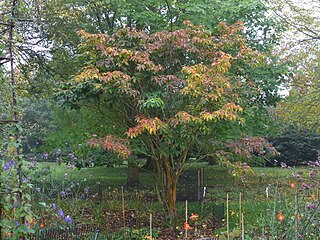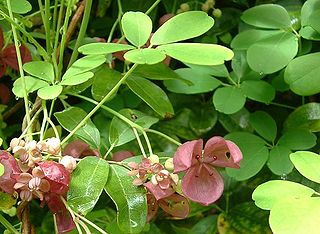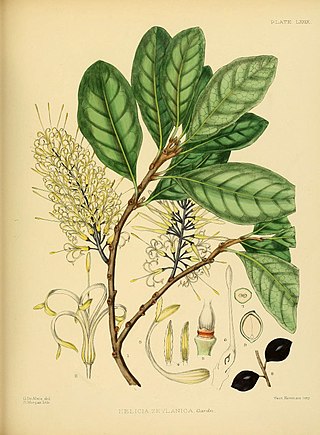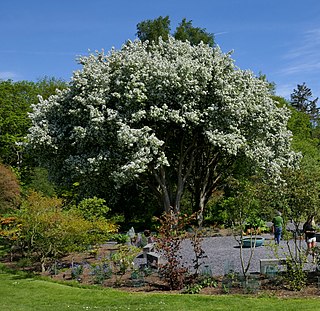Cypress is a common name for various coniferous trees or shrubs of northern temperate regions that belong to the family Cupressaceae. The word cypress is derived from Old French cipres, which was imported from Latin cypressus, the latinisation of the Greek κυπάρισσος (kyparissos). Cypress trees are a large classification of conifers, encompassing the trees and shrubs from the cypress family (Cupressaceae) and many others with the word cypress in their common name. Many cypress trees have needle-like, evergreen foliage and acorn-like seed cones.

Lactuca, commonly known as lettuce, is a genus of flowering plants in the family Asteraceae. The genus includes at least 50 species, distributed worldwide, but mainly in temperate Eurasia.

Persicaria maculosa is an annual plant in the buckwheat family, Polygonaceae. Common names include lady's thumb, spotted lady's thumb, Jesusplant, and redshank. It is widespread across Eurasia from Iceland south to Portugal and east to Japan. It is also present as an introduced and invasive species in North America, where it was first noted in the Great Lakes region in 1843 and has now spread through most of the continent.

Microbiota is a monotypic genus of evergreen coniferous shrubs in the cypress family Cupressaceae, containing only one species, Microbiota decussata. The plant is native and endemic to a limited area of the Sikhote-Alin mountains in Primorskiy Krai in the Russian Far East. Microbiota is not to be confused with the range of microorganisms of the same name. The genus name was derived from micro-, meaning "small", + Biota, the genus name for a closely related conifer, a species formerly called Biota orientalis, now renamed Platycladus orientalis.

Glyptostrobus pensilis, known in Chinese as 水松, and also Chinese swamp cypress, is an endangered conifer, and the sole living species in the genus Glyptostrobus.

Neoshirakia, known as milktree, is a genus of plants in the Euphorbiaceae, native to east Asia. It is part of a group first described in 1954 with the name Shirakia, but this proved to be an illegitimate name, unacceptable under the Code of Nomenclature. The genus was later divided, with its species distributed amongst three genera: Neoshirakia, Shirakiopsis, and Triadica. Neoshirakia contains only one known species, Neoshirakia japonica, known as tallow tree, native to China, Korea, and Japan. The name Shirakia thus became a synonym of Neoshirakia because S. japonica was the type species for that genus, the species now renamed N. japonica.

Quercus acutissima, the sawtooth oak, is an Asian species of oak native to China, Tibet, Korea, Japan, Indochina and the Himalayas. It is widely planted in many lands and has become naturalized in parts of North America.

Lardizabalaceae is a family of flowering plants.

Nepenthes eustachya is a tropical pitcher plant endemic to Sumatra, where it grows from sea level to an elevation of 1600 m. The specific epithet eustachya, formed from the Greek words eu (true) and stachys (spike), refers to the racemose structure of the inflorescence.

Ulmus szechuanicaFang, known as the Szechuan (Sichuan), or red-fruited, elm, is a small to medium deciduous Chinese tree found along the Yangtze river through the provinces of Sichuan, Jiangxi, Anhui, and Jiangsu.
Aralia dasyphylla is a species in the plant genus Aralia, family Araliaceae. Its native range is western Malesia. Some sources include Aralia dasyphylloides from southern China in this species.

Sium is a genus of flowering plants in the family Apiaceae. It is widely distributed across Europe, Asia, Africa, and North America. Plants of this genus are commonly called water parsnips.

Campylospermum serratum is a plant in the family Ochnaceae. The specific epithet serratum is from the Latin meaning "with teeth", referring to the leaf margin. It is found in Tropical Asia, from Sulawesi, Indonesia to Hainan, Zhōngguó/China and over to southwester India. Gomphia serrata was a previous common name for the species. The plant is used for it wood and its sap is used in folk medicine and in the past for teeth-blackening.

Helicia is a genus of 110 species of trees and shrubs, constituting part of the plant family Proteaceae. They grow naturally in rainforests throughout tropical South and Southeast Asia, including India, Sri Lanka, Indochina, Peninsular Malaysia to New Guinea and as far south as New South Wales.

Malus hupehensis, common names Chinese crab apple, Hupeh crab or tea crabapple, is a species of flowering plant in the apple genus Malus of the family Rosaceae.
Hubbardochloa is a genus of African plants in the grass family. It was named after British botanist Charles Edward Hubbard (1900–1980). The only known species is Hubbardochloa gracilis, native to Rwanda, Burundi, and Zambia.

Najas marina is a species of aquatic plant known by the common names spiny water nymph, spiny naiad and holly-leaved naiad. It is an extremely widespread species, reported across Europe, Asia, Africa, Australia, the Americas and many oceanic islands. It can be found in many types of freshwater and brackish aquatic habitat, including bodies of alkaline water.

Eucommia is a genus of small trees now native to China, with a fossil record that shows a much wider distribution. The single living species, Eucommia ulmoides, is near threatened in the wild, but is widely cultivated in China for its bark, and is highly valued in herbology such as traditional Chinese medicine.

Reineckea is a genus of plants in the Nolinoideae. Several species names have been proposed within the genus, but only one is widely accepted: Reineckea carnea, native to China and Japan.

Salix erioclada is a species from the genus of willows (Salix) and grows as a shrub or small tree. The leaf blades have a length of about 5 centimeters. The natural range of the species is in China.

















